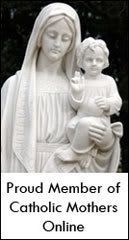II. The Signs and the Rite of Confirmation
In Biblical symbolism anointing with oil is a symbol of abundance and joy, cleansing, strengthening, healing and beautifying. Christian who receive the anointing of Confirmation share in the mission of Jesus Christ and the work of the Holy Spirit. In Confirmation we receive the mark of the Holy Spirit, a symbol of belonging. Christ himself said that he was marked with his Father's seal.
The rite of Confirmation is preceded by the consecration of the chrism oil by the bishop at the Chrism Mass. The rite itself begins with a renewal of baptismal promises to emphasize the connection between the two sacraments. The essential rite of the sacrament involves the bishop anointing the forehead with chrism through laying on of hands and saying the words, "Be sealed with the Gift of the Holy Spirit." In the Byzantine rite the forehead, eyes, nose, ears, lips, chest, back, hands and feet are all anointed. The sign of peace concludes the rite to demonstrate the ecclesial communion of the bishop with all the faithful.
III. The Effects of Confirmation
 The effect of Confirmation is the outpouring of the Holy Spirit as at Pentecost. It gives us the following graces:
The effect of Confirmation is the outpouring of the Holy Spirit as at Pentecost. It gives us the following graces:- it roots us more deeply in the divine filiation which makes us cry, "Abba! Father!"
- it unites us more firmly in Christ
- it increases the gifts of the Holy Spirit in us
- it renders our bond with the Church more perfect
- it gives us a special strength of the Holy Spirit to spread and defend the faith by word and action as true witnesses of Christ, to confess the name of Christ boldly, and never to be ashamed of the Cross.
Confirmation, like Baptism, also confers an indelible spiritual mark.
IV. Who Can Receive This Sacrament?
Every baptized person not yet confirmed should receive the sacrament of Confirmation. The Church suggests the "age of discretion" be reached, but children in danger of death should be given the Sacrament. Preparation should be made including catechesis that emphasizes belonging to the universal Church and parish community, receiving the Sacrament of Penance and more intense prayers.
V. The Minister of Confirmation
The original minister of Confirmation is the bishop, but he can authorize priests to administer the sacrament. If someone is near death, any priest can give Confirmation.
Article 3 The Sacrament of the Eucharist
I. The Eucharist- Source and Summit of Liturgical Life
The other Sacraments are all bound up in the Eucharist and oriented towards it.
"The Eucharist is the efficacious sign and sublime cause of that communion in
the divine life and that unity of the People of God by which the Church is kept
in being. It is the culmination both of God's action sanctifying the world
in Christ and of the worship men offer to Christ and through him to the Father
and to the Holy Spirit."CCC 1325
In the Eucharistic celebration we unite with the heavenly liturgy and anticipate eternal life.
The inexhaustible richness of this sacrament is expressed in the variety of names given to it:
- Eucharist
- The Lord's Supper
- The Breaking of Bread
- The Eucharistic Assembly
- The memorial of the Lord's Passion
- The Holy Sacrifice
- The Holy and Divine Liturgy
- The Sacred Mysteries
- The Most Blessed Sacrament
- Holy Communion
- Holy Mass
III. The Eucharist in the Economy of Salvation
The signs of bread and wine
At the heart of the Eucharistic celebration are bread and wine which through the words of consecration become Christ's body and blood. Bread and wine also symbolize the goodness and of creation as we see in the Old Testament. In the New Testament the miracles of the multiplication of the loaves and the wedding at Cana prefigure the superabundance of the Eucharist.
By celebrating the Last Supper with is disciples, Christ gave the Passover its definitive meaning. Christ's death and Resurrection are the new Passover and an anticipation of the final Passover of the Church and the glory of her kingdom.
"Do this in memory of me"
Jesus commanded us to repeat his words and actions until he comes, not merely remember what he did. On the first day of the week the early Christians would meet to break bread. The celebration of the Eucharist has continued to this day, and remains the center of the Church's life.
"Thus from celebration to celebration, as they proclaim the Paschal mystery
of Jesus 'until he comes,' the pilgrim People of God advances, 'following the
narrow way of the cross,' toward the heavenly banquet, when all the elect will
be seated at the table of the kingdom." CCC 1344
IV. The Liturgical Celebration of the Eucharist
The Mass has stayed the same since the second century. It has two parts: the liturgy of the Word and the liturgy of the Eucharist.
The movement of the celebration
- all gather together
- liturgy of the Word
- the presentation of the offerings
- the anaphora
- the preface
- the epiclesis
- the institution narrative
- anamnesis
- intercessions
- communion
Questions for Reflection:
What a lot of great information on the Eucharist! A lot of food for reflection here!
I don't have any specific questions this week, but welcome your comments!



No comments:
Post a Comment